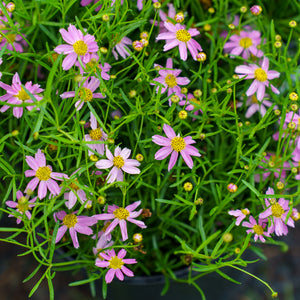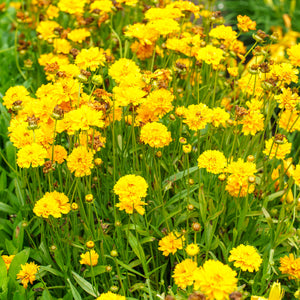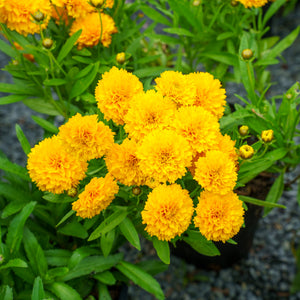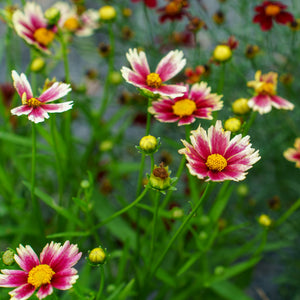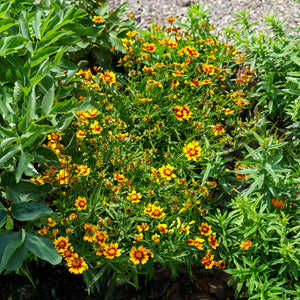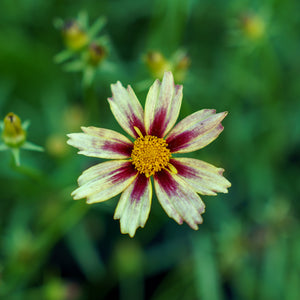Coreopsis: Reliable Color and Pollinator Power for Sunny Gardens
Welcome to this week’s edition of our "Plant of the Week" series. Few perennials offer as much easy-going, sun-loving color as Coreopsis, commonly known as Tickseed. Native to North America and widely appreciated for its long bloom season, Coreopsis brings vibrant, daisy-like flowers in bold shades of yellow, red, orange, and pink. Blooming reliably from late spring into fall, this hardy perennial thrives in sunny gardens and fills beds and borders with cheerful, low-maintenance color. Whether you're planting a pollinator garden, designing a drought-tolerant landscape, or just looking for something that blooms nonstop—Coreopsis delivers.
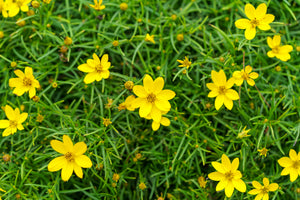

What Makes Coreopsis Special?
Coreopsis stands out for its extended bloom period, typically beginning in late May and continuing through the heat of summer into early fall. The bright flowers sit atop slender stems, often above fine-textured or threadleaf foliage, depending on the variety. These long-blooming perennials come in a range of forms—from compact mounds to looser, meadow-like shapes—and attract a wide variety of butterflies and bees.
This plant is prized for its heat and drought tolerance, once established. It grows best in full sun and well-drained soil, where it will perform without fuss and even thrive in poor soil conditions. Coreopsis is typically hardy in USDA Zones 4–9, making it a strong performer across New Jersey and beyond.
Many varieties, such as Coreopsis verticillata 'Moonbeam' and Coreopsis grandiflora 'Early Sunrise', are repeat bloomers, especially when deadheaded. Newer hybrids offer exciting flower forms and colors, including bicolored blooms, ruffled petals, and bold red or pink shades.
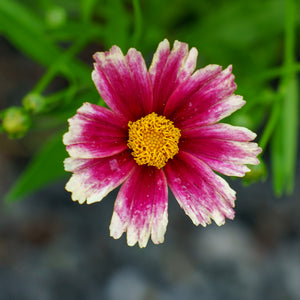
How to Use Coreopsis
With its versatility and carefree nature, Coreopsis fits seamlessly into a wide range of garden designs.
Pollinator & Wildlife Gardens: Coreopsis is a magnet for bees, butterflies, and native pollinators. Use it in wildlife-friendly borders, meadows, or native garden designs where its continuous bloom helps sustain pollinator activity throughout the season. Pair with Echinacea, Asclepias, or Monarda for a nectar-rich environment.
Sunny Borders & Perennial Beds: Whether planted in large drifts or tucked between other plants, Coreopsis provides a strong splash of color and helps unify mixed plantings. Varieties like ‘Zagreb’ or ‘Jethro Tull’ are ideal for adding contrast to purple-flowering plants like Salvia or Nepeta.
Mass Plantings & Ground Covers: Low-growing Coreopsis varieties make excellent ground covers or mass plantings. Their tidy mounds and bright blooms can line walkways, soften slopes, or add color to sunny hillsides with minimal care. Spaced appropriately, they form dense patches that suppress weeds and reduce maintenance.
Containers & Small Gardens: Compact types like ‘Lil’ Bang Red Elf’ or ‘Uptick Gold & Bronze’ are ideal for containers, balconies, or smaller beds, where their tidy habits and repeat blooms provide season-long interest in a confined footprint.
Focal Point for Summer Color: Though often used en masse, a single large Coreopsis—especially one with ruffled or bicolor flowers—can serve as a focal point in a smaller garden bed or a monochromatic planting. Its bright coloring draws the eye and creates a sunny centerpiece.

How to Care for Coreopsis
Coreopsis is among the easiest perennials to grow. Follow these care tips for maximum bloom and health:
Planting: Choose a spot in full sun with well-drained soil. Avoid overly wet areas, especially in winter. Amend with compost if the soil is poor, but heavy fertility is not required.
Watering: Water regularly during the first growing season to establish roots. Once established, Coreopsis is moderately drought-tolerant, needing little supplemental water.
Deadheading: Regular removal of spent flowers encourages continued blooming well into late summer. Some modern varieties are self-cleaning, reducing the need for deadheading.
Pruning: Shear plants back by one-third in midsummer if they become leggy or if flowering slows. This will promote new growth and a fresh round of blooms.
Fertilizing: Avoid over-fertilizing, which can lead to floppy growth. A light spring feeding with a balanced fertilizer is usually sufficient.
Pests & Disease: Coreopsis is relatively pest-free, though excessive humidity can cause powdery mildew in crowded conditions. Good airflow and spacing help prevent problems.
CONCLUSION
Coreopsis brings effortless color, extended bloom time, and pollinator power to sunny gardens all across New Jersey. Whether you're planting for wildlife, building a low-maintenance border, or filling containers with long-blooming brightness, Coreopsis is a reliable, rewarding perennial that performs year after year. With dozens of cultivars to choose from, it’s easy to find a variety that fits your garden style—and keeps blooming through the summer heat.
Check out the entire 'Plant of the week' series
The Coreopsis Collection
Sold Out

